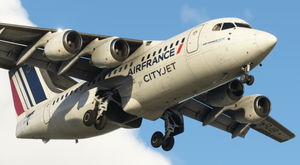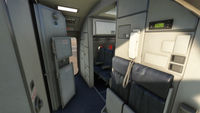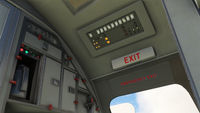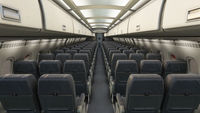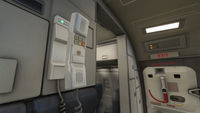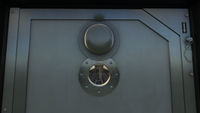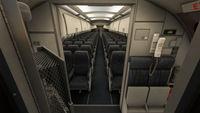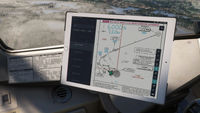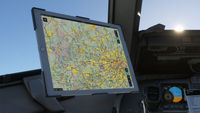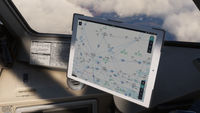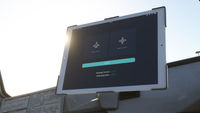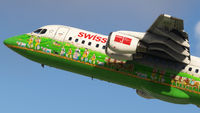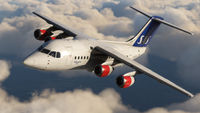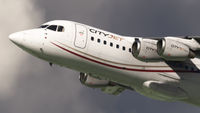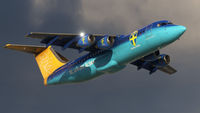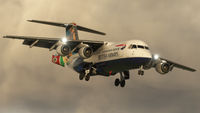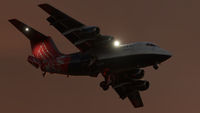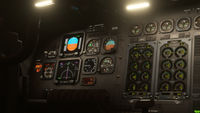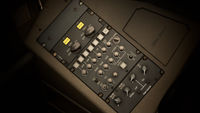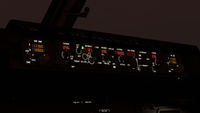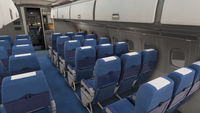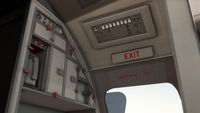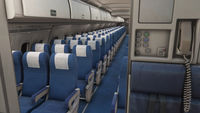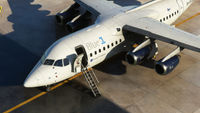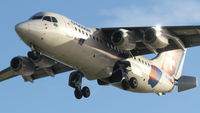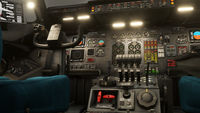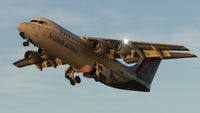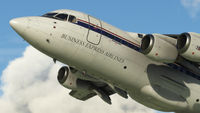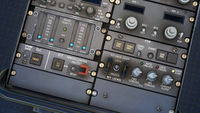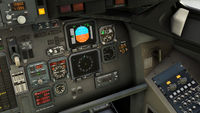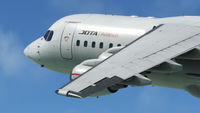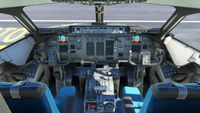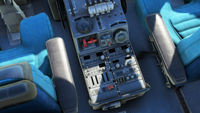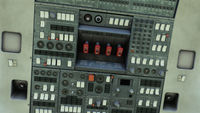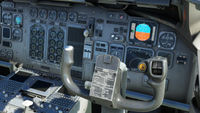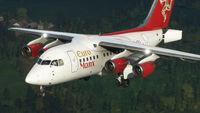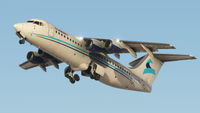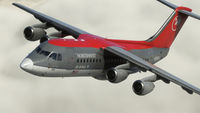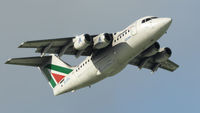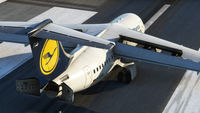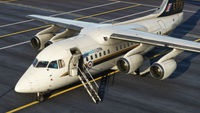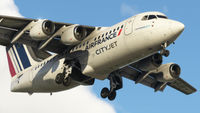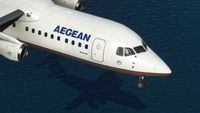With substantial progress continuing to be made on the RJ Professional, the development team along with the assistance of the testing team have been hard at work finding and squashing bugs as we continue to apply polish to the product ahead of release.
RJ Professional
Just Flight are excited to bring you all three variants of the RJ family: the RJ70, RJ85 and RJ100. Each variant is fully custom-coded and created using comprehensive, hands-on research with a real world aircraft, RJ-100 SE-RJI. Over 25 high quality liveries represent the vast number of RJ operators from all around the world.
The RJ was developed in the 1980s and 1990s and first took to the air in 1992. The main goal of the RJ was to succeed the 146 regional jets, many of which were still flying in their original analogue cockpit configurations and without sophisticated autopilot or navigation systems. This, along with newer and more modern regional jets from other manufacturers, meant that it was beginning to prove difficult for airlines to operate the 146 in the modern-day aviation environment and a new aircraft was required.
The results of those efforts was the RJ, a glass cockpit airliner equipped with an EFIS (Electronic Flight Instrument System), PED (Primary Engine Display), FADEC (Full Authority Digital Engine Control) and FMS (Flight Management System) - a generational leap in capability from the 146.
Other avionics improvements include a fully automatic pressurisation system, digitally displayed COM/NAV/ADF radio, an autothrottle, a TRP (Thrust Rating Panel) allowing you to set V-speeds on the EFIS displays as well as select different engine power modes and a much more advanced autopilot, with LNAV and CAT3 autoland capabilities. The aircraft was also fitted with an FMS as standard, which in our simulation comes in the form of a fully custom-coded GNLU-910A.
Amongst all of these more advanced features, the RJ and the 146 both share the same type rating; there are, therefore, a lot of similarities in the operating philosophies between the two aircraft. A true mix of retro and modern and a really quirky aircraft to study and to fly!
See the Detailed Description below for full details of all the aircraft features!
The following PDF manuals are included with the aircraft software and you can also download them here: Operations Manual / EFB Manual /GNLU-910A FMS Manual
VARIANTS
All three variants of the RJ are included:
- RJ70
- RJ85
- RJ100
MODEL
- Accurately modelled using real-world aircraft plans and comprehensive photography of the real aircraft (RJ100 SE-RJI)
- Custom-modelled ground equipment (GPU, chocks)
- Optional equipment correctly configured for each livery (HF antennas, VHF3 antenna, tail skid)
- Highly detailed passenger cabin and galleys customised for each RJ variant, with fully simulated forward and rear galley controls
- Numerous animations, including trailing edge flap surfaces, wing-mounted lift spoilers and tail-mounted airbrakes, all cockpit, passenger, service and cargo doors, integral airstairs, windscreen wipers, distinctive retractable tricycle landing gear, and more
- Physically Based Rendering (PBR) materials produce realistic metallic, plastic and glass surfaces
- 4K and 8K textures used throughout the product to produce the highest possible texture clarity
- Authentic labelling and placards based on those found in the real aircraft, with decals used for high-resolution text
- MSFS ground services support (marshaller, fuel truck etc.)
- Full support for MSFS visual icing effects
COCKPIT
- Captain and First Officer positions are modelled with hundreds of functional switches, knobs and controls. Even the pilot and observer seats, cup holders and sun visors are functional!
- A truly 3D cockpit environment right down to accurately modelled seat belts and screw heads - every instrument is constructed fully in 3D with smooth animations
- Cockpit textures feature wear and tear based on reference photos taken in the real aircraft to produce an authentic environment
- Accurately modelled CRT, LCD and LED displays
- Custom-coded GNLU-910A FMS
- Aircraft state system which will automatically save the aircraft state whenever a flight is saved and reload it whenever that flight is loaded
- Aircraft configuration system which allows you to choose between 'Cold & Dark', ‘Turnaround’ or 'Ready for Take-off'
- Many features have been added to help with usability such as the ability to hide the control yokes for a better view of the instruments and pre-set camera views for the overhead panel, centre pedestal and jump seat, hidden clickspot for setting all altimeters to standard and controlling all four N1 and TGT bugs, and automatic ground idle selection
- Developed using the latest MSFS standards, including intuitive and easy-to-use controls for rotary knobs, multi-position switches and levers
- Fully compatible with MSFS VR mode
- EFB tablet with a plethora of features including boarding simulation, failures menu and interactive checklists, as well as SimBrief and Navigraph support
- Fully interactable and customisable paper charts and checklists
LIVERIES
The RJ comes with a variety of liveries representing the aircraft's numerous operators from all around the world:
RJ70
- Alitalia Express (EI-CPJ)
- Business Express Airlines (N832BE)
- ETPS (QQ102)
- Euro Manx (EI-CPJ)
- QinetiQ (G-ETPK)
- SAS (SE-DJY)
- Air France (EI-RJB)
- Airlink South Africa (ZS-TCO)
- Blue1 (OH-SAO)
- Braathens (SE-DJO)
- Brussels Airlines (OO-DJX)
- CityJet (EI-RJO)
- Crossair (HB-IXH)
- Lufthansa (D-AVRB)
- Northwest Airlink (N525XJ)
- Northwest Jet Airlink (N519XJ)
- Sabena (OO-DJK)
- Aegean (SX-DVC)
- Atlantic Airways (OY-RCC)
- British Airways (G-BXAS)
- British Airways – Colum (G-BZAU)
- Brussels Airlines (OO-DWH)
- Cobham (VH-NJQ)
- Jota Aviation (G-JOTS)
- Malmo Aviation – Swedish Football (SE-DSU)
- North Cariboo Air (C-FSUA)
- Summit Air (C-FXRJ)
- Swiss (HB-IXT)
- Swiss - Zurich Airport Shopping Paradise (HB-IYS)
SYSTEMS
RJ Professional features fully custom-coded aircraft systems with a high degree of complexity and depth, including:
Air-conditioning and pressurisation system
- Automatic and manual pressurisation modes with control of outflow valves, barometric and cabin rate settings, indications and cabin altitude warnings
- Cabin altitude and differential values based on real-world data
- Automatic and manual flight deck and cabin temperature control – takes account of ambient temperature, the amount of direct sunlight hitting the aircraft, air supply from the engines and/or APU, fresh or recirculated air and even whether the doors are open!
- Simulated FLT DECK AIR functionality, which when enabled, diverts all air flow from PACK 1 to the cockpit
- Realistic APU start and shutdown procedures, and bleed air and electrical power supply
- RPM, TGT and fuel burn values based on real-world data
-
Autopilot and flight director system with multiple modes:
- Pitch – ALT HLD, APP, LVL CHG and V/S
- Roll – HDG SEL, LVAV (FMS) and VOR LOC
- Autothrottle
- Flight director SYNC mode for manual changes of pitch in IAS and VS modes - Fully functional mode annunciations, engagement and disengagement criteria (including roll and pitch rate cut-out and stall cut-out) and integration with EFIS PFD and ND
- Simulated CAT 3 Autoland capability
- Custom-coded GNLU-910A FMS
- Dual VHF COMM, NAV and ADF radios, with 8.33kHz spacing support
- Cockpit voice recorder test and indication systems
- Functioning audio selector, with options to adjust the volume of ATC communications and pilot/cabin crew interactions
- PA chimes and cockpit/cabin interaction
- Animations panel for controlling passenger and service doors, and lower cargo doors
- Deployable airstairs, powered by the Yellow hydraulic system
- Optionally fitted Airstairs Accumulator via an option on the EFB, when fitted, this stores hydraulic pressure in an accumulator allowing up to two full retractions of the airstairs without the Yellow hydraulic system being pressurised
- Optionally fitted Airstairs Lights via an option on the EFB, controllable via a STAIR RETRACTION switch in the forward galley
- Doors and airstairs can be controlled manually via their respective handles and levers in the cabin, or via buttons on the EFB
- Independent engine, APU and external power (AC and DC) sources
- Generator and TRU loading, and automatic load switching
- Standby generator and inverter power sources for non-normal procedures
- Independent AC channels, including normal, essential and emergency busbars, and bus-tie facilities
The aircraft is equipped with a tablet EFB for controlling various aircraft options and payloads, including:
- Set fuel quantity in individual tanks (including total fuel weight, automatically split between tanks)
- Set payloads in passenger cabin and cargo holds (including Zero Fuel Weight)
- Control the pilot and cabin announcements
- Quickly select aircraft states (Ready for Take-off, Turnaround and Cold-and-Dark)
- Toggle ground power unit (GPU) and chocks
- Monitor CG position and automatically set take-off trim based on CG
- Aircraft configuration menu with many options, including altimeter sync, traditional/TCAS VSI, state saving, cabin lighting, model customisation options and much more
- Import your SimBrief flight and view a summary or scrollable full OFP
- Monitor your position in real time using a map view with tracking, zoom and pan options
- Support for Navigraph Airport Charts and Navigraph En Route Charts (requires an active Navigraph subscription)
- Use a notepad for making notes during the flight, particularly useful for noting down clearances and taxi instructions
- Realistic and accurate performance in the air and on the ground, using unique flight models for all variants based on real-world performance and handling data, and input from real-world RJ pilots and engineers
- Custom effects for enhanced immersion, including engine, APU and GPU exhaust haze
- Complete exterior lights package as seen on the real RJ, including landing, wing, runway, logo and taxi lights that illuminate objects and the ground, for ease of operation during the hours of darkness
- Engine, APU and fuselage fire detection and warning systems
- Engine fire extinguishing system
- Fully simulated test functionality
- Servo-tab simulation – the position of elevator and aileron surfaces is dependent on servo-tab control inputs and airflow over the surface
- Iconic tail-mounted airbrakes, roll and lift spoilers with independent hydraulic sources, realistic deployment times and custom AC and PTU pump sounds
- Flight control disconnect and yoke control lock functionality
- Accurately simulated flap system with hydraulic and electrical power sources, baulk override, fault testing and iconic howl when deployed in the air
- Stall identification and warning systems, including stick shaker and pusher, and inhibit mode
- Simulated configuration warning system
- Flap Trim Compensation (FTC) system
- Custom-coded GNLU-910A FMS for lateral navigation (LNAV) and vertical navigation (VNAV)
- Fully simulated IDENT, RTE, LEGS, HOLD, PROG, FIX, DEPARR, VNAV CLB, VNAV CRZ and VNAV DES pages, and many more!
- Autopilot-coupled LNAV including integration with the EFIS PFD and ND
- Ability to manually input flight plans or import them automatically via Company Route integration
- SID and STAR support
- Holding pattern support
- Navigation and performance monitoring, including ETA and fuel estimations
- Simulated VNAV approach functionality, this provides an advisory VNAV (AVNAV) vertical deviation indicator for non-precision approaches when within the terminal area of the arrival airport
- Top of Climb and Top of Descent calculations integrated with the EFIS ND
- Realistic fuel load and burn based on real-world data
- Simulated electrical normal and hydraulic standby fuel pumps, centre and wing tanks with feed tanks for each engine, and LP and HP fuel cocks
- Fully functional centre-to-wing fuel transfer, cross-feed and common-feed valves
- Auxiliary fuel tanks fitted (can be toggled via the EFB) to provide additional range - great for bizjet operations
- Independent yellow and green hydraulic systems with realistic pressure, quantity and supply to other systems
- Simulated AC and DC driven back-up pumps and power transfer unit (PTU)
- Functional standby generator for supplying AC and DC electrical power in non-normal situations
- Simulated depleting brake pressure over time when hydraulic supply is removed or the emergency brake system is used
- Simulated airbrake deployment over time when hydraulic supply is removed and the airbrake locks fail
- Ice detection and accumulation simulation, anti-icing and de-icing functionality for exterior surfaces, warning systems for in-flight monitoring
- Simulation of separate inner and outer wing anti-icing, and windscreen overheating
- A vast array of annunciators, including accurately simulated Central Warning Panel (CWP) and Master Warning System (MWS) with amber and red cautions, audible warnings and ground testing for all systems
- Simulated Cockpit Voice Recorder (CVR), Flight Data Recorder (FDR) and Quick Access Recorder (QAR) functionality and ground tests
- Aircraft clock with all modes simulated
- Normal and emergency gear extension, including gear down-lock override
- Gear configuration indication and warning systems
- Simulated brake accumulators supplied via the hydraulic power sources (yellow or green), anti-skid and brake temperature indicator with cooling down periods that are affected by ambient temperature, brake usage and brake fans
- Captain and First Officer tillers for realistic nose-wheel steering
- An EFB option toggles between realistic nose wheel steering using tillers or a more compatible nose-wheel steering with rudder pedals
- Independent lighting controls for Captain and First Officer
- Dimmable integral lighting for each panel
- Dimmable dynamic flood and storm lighting for a highly immersive and customisable night environment (more than 10 individual light sources, including entry, lap, sill and flight kit)
- Freely moveable lap and sill lighting
- Dimmable brightness of EFIS PFD, EFIS ND and FMS displays
- LCD and LED displays vary brightness automatically based on ambient lighting conditions
- Accurately simulated exterior lighting, including wing, logo and runway exit lights, and taxi/landing and navigation lights with different intensities
- Realistic passenger cabin lighting for forward and rear galleys, side wall lighting and ceiling lighting, including bright/dim controls
- Simulated emergency lighting in cockpit and cabin
- Dual Inertial Reference System (IRS) with realistic alignment times that vary based on the aircraft’s latitude. Alignment can be as quick as 2.5 minutes at the equator, or up to 15 minutes at far north/south latitudes. A fast alignment option is included.
- Independent EFIS PFDs, EFIS NDs and FMSs for both Captain and First Officer
- Mode Control Panel (MCP) housing autopilot mode buttons, mode adjustment knobs, and target values displayed in LCD windows
- Dual RMI/DBI navigation instruments, fed by two VHF NAV and ADF radios, including DME hold function
- FMS/EFIS source selector for LNAV 1, LNAV 2 or split navigation via the EFIS PFD, ND and auto-flight system
- Fully functioning test modes on navigation instruments (e.g. EFIS PFD, EFIS ND, FLT TEST ANNUNS, DME)
- Transponder with TCAS (integrated with the TCAS traffic display) and simulated TCAS test
- Custom-coded EGPWS with modes 1-6, steep approach mode, flap warning override and test functionality
- Flight crew and passenger oxygen systems with valve and mask deployment controls
- Highly detailed and fully interactable passenger cabins for each of the RJ variants
- Unique RJ cabin features include a curved aft cabin where seat layout reduces from a 3+3 to a 2+2 configuration for the last few rows, window blanks and smaller overhead bins in the centre of the cabin
- Extensive simulation of the cabin environment, including fully animated and interactable cabin doors and airstairs, lighting controls, cabin call panels and even a functional coffee maker and circuit breakers
- Ground service electrical bus simulation
- Independent lighting controls for galleys, ceiling, side wall, toilet and worktop, including bright/dim controls
- AUTO CABIN CREW option on the EFB that, when enabled, simulates the cabin crew performing their duties during the flight, including responding to cabin call chime, playing cabin music during passenger boarding and after landing, and performing passenger announcements
- Fully simulated music player with play, pause, skip, shuffle, repeat and volume functions
- Potable water that depletes throughout the flight and varies depending on coffee maker usage
- Realistic bleed air demand from engines and APU, and pneumatic supply to air-conditioning and ice protection systems
- Fully custom-coded FADEC (Full Authority Digital Engine Control)
- N1, N2, EGT, oil pressures and temperatures will all differ subtly between engines
- Fully simulated Primary Engine Display (PED), including engine indications, fuel flow and fuel quantity in KGS and LBS, overspeed/overtemperature warnings and manual override controls for N1 % RPM bugs
- Accurately simulated Thrust Rating Panel (TRP) with TOGA (MAXimum or REDUced), MCT (Maximum Continuous Thrust) and CLB (MAXimum or NORMal) modes. Takes account of engine bleed air requirements, e.g. for air conditioning and ice protection systems.
- Realistic engine start procedures with external, APU or cross-start sources, including accurate EGT behaviour
- Take-off and landing speed card which automatically displays reference speeds depending on current aircraft weight
- MSFS-native (Wwise) sound package taking full advantage of MSFS’ capabilities
- Studio quality Lycoming ALF-507 engine noise recorded from the real aircraft
- Over 450 flight deck sound effects recorded from the real aircraft
- Detailed equipment audio such as the avionics fans, APU, brake fans, electrical circuits, hydraulic equipment and many more
- Distinctive flap retraction/extension airflow ‘howling’ sound
- Detailed physics-based effects on engine and wind noise
- Accurately positioned 3D sound sources (best enjoyed in VR!)
- Custom crash and scraping effects
- Cabin audio for chimes, airstairs and doors, and even a functional coffee maker that brews coffee!
- Fully functional music player with seven music tracks as standard and the ability to import custom music tracks
OTHER FEATURES
- Extemsive Operations Manual with flight tutorial, systems guide, procedures, limitations and handling notes
- EFB manual with detailed information on all EFB features
- GNLU-910A FMS Operations Manual with dedicated tutorial flight
- Multiple interior and exterior camera presets, including wing views
- PSD paintkit available so you can create your own livery and cabin textures
- MSFS interactive checklist support (manual and Automatic/Co-pilot modes)
- Interactive paper charts and checklists in the cabin, with options to import custom documents
- EFB option to toggle the units of measurement used throughout the cockpit between KGS and LBS
- Support for numerous control assignments for compatibility with controllers and hardware
- GSX compatible; aircraft profiles included for each RJ variant
Development Updates
With substantial progress continuing to be made on the RJ Professional, the development team along with the assistance of the testing team have been hard at work finding and squashing bugs as we continue to apply polish to the product ahead of release.
We're back with a new In-Development update for our RJ Professional! This time we take a look at the brand new passenger cabins.
We have modelled the passenger cabin in a common 3+3 layout with grey leather seats, a stark contrast to the 1980’s style blue fabric seats that could be found in our 146 Professional. The cabins are custom modelled for each of the three RJ variants, taking into account the nuances of each variant such as blanked out windows, smaller overhead stowage bins in the centre of the cabin where the wing structure and centre fuel tank are located and a reduction in seats per row at the rear of the cabin as the fuselage sharply begins to narrow.
Although we haven’t tried to replicate one particular airline’s cabin 1:1, we feel the cabin perfectly serves its purpose of acting as a generic cabin that can be realistically used whatever the livery you choose to fly. For the talented painters in the community, the cabin will be included in the paint kit should you wish to customise it with your liveries.
Like our other airliners in MSFS, we have gone all-out with the functionality in the cabin, from simulated controls in the forward and rear galleys, cabin to cockpit communications and of course a return of the ‘study level’ coffeemaker!
Although the 146 and RJ may visually look similar from the exterior, upon entering the cabin users of our 146 Professional will notice some significant changes in the galleys which have been modernised. Gone is the bulky communications panel on the rear wall of the forward galley, this has now been replaced with a handset. The handset can be removed from it's cradle via a single click and rotates out towards you as if you are making a call. Using a mixture of the buttons on the handset and the annunciators on the cradle, calls can be made between the forward and aft galley, passenger cabin and cockpit. All of these communications are accurately simulated with the correct annunciators and chimes simulated at each station as well as in the cockpit.
Above the service door in the forward galley we have the attendant panel. This panel is used for controlling the cabin lighting and can also be used to view the status of the cabin doors, crew call lights and fasten seatbelt/no smoking signs. If a Ground Power Unit (GPU) is connected to the aircraft, electrical power can also be applied to the cabin via the ground service power switch. With a GPU connected to the aircraft and the switch set to the ON position, the ground service bus will be energised providing electrical power to the cabin’s systems. This is a useful tool for any non-cockpit crew as it allows electrical power to be applied to the passenger cabin without the need for a pilot or engineer in the cockpit. Users of the 146 Professional will also notice that there is a slightly different layout on this panel in the RJ Professional and that is due to the addition of two BRT/DIM switches for the cabin ceiling and side wall lighting.
If you are the type of person that just enjoys flying the aircraft and doesn’t want to get too involved with the passenger cabin simulation, we have catered for you too. With the “Auto Cabin Crew” option enabled on the EFB, the cabin crew will perform all of the cabin duties for you, without you ever having to leave the cockpit. You will even hear noises from the cabin such as passenger boarding/deboarding the aircraft, chimes from passenger and crew calls, coffee brewing and even music during boarding and after landing. That’s right, the digital music player also makes a return in the RJ Professional allowing you to play one of up to seven included songs or you can import some custom music of your own! If you do wish to have a peak into the cabin whilst your flying, you can take a look through the viewing window on the newly modelled enhanced security door. The door which opens outwards into the galley features two large blow-out panels on its lower half which are used to equalise the pressure between the cockpit and cabin in the case of a rapid depressurisation. The door also features an electronic lock with controls located on the pedestal. The passenger cabin can also be disabled entirely via an option on the EFB, which may benefit users who wish to slightly increase their FPS via a reduction in VRAM usage.
An interesting fact you may not have known about the aircraft is despite the difference in fuselage length between the RJ85 and RJ100, both variants actually have the same maximum occupancy limit of 118 people (including passengers and crew). This is due to both aircraft sharing the same emergency exit arrangement and therefore are both limited by the number of exits rather than the physical space available in the aircraft. This limitation is less impactful to mainline operators of these variants who can make up for the lost revenue by selling seats in a business class cabin.
Also some great news, the rest of the product is effectively feature complete now and we are beginning to enter the “polishing” phase which includes a lot of intensive testing as we attempt to break the product prior to release, just so you don’t have to! We’ll be sure to keep you posted on the progress of the RJ Professional and you can expect to see some preview videos of the product in the near future. Enjoy the pics!
In this latest development update for our upcoming RJ Professional we highlight some of the brand new features that will be included with the EFB.
Headlining the list of new features is the addition of Navigraph Enroute Charts. When opening the Charts app on the EFB, there is now an option to display Airport Charts or Enroute Charts. The Enroute Charts page has four options to toggle the type of chart shown: IFR High Altitude, IFR Low Altitude, VFR, and World Map, meaning that there is a chart available regardless of the type of flight or location. These maps can be centred on the aircraft’s present position and can move with the aircraft as it navigates airways, or they can be moved freely to view airways and navaids that may not be in the immediate vicinity. A dark mode toggle is also available to preserve that all important night vision during those late night flights.
For non-Navigraph subscribers, the traditional Map app will remain available for use.
On the Airport Charts page, search, view and save any airport chart that is included within Navigraph’s vast database. There are also some much requested additions to this page compared to previous version of the EFB, the most notable being the ability to draw on the airport charts. No more having to remember longwinded taxi instructions, simply draw the taxi path on the chart and enable the aircraft icon to monitor the aircraft’s present position.
In addition to all of this, the RJ Professional will still feature many other customisation options and quality of life features that you have come to be familiar with in our other MSFS aircraft, such as SimBrief integration, boarding and refuelling simulation, failures and more!
Although we anticipate that these new features will debut with the release of the RJ Professional, we will also be integrating them into all of our other MSFS products as free of charge updates. Stay tuned for further developments as we get ever closer to the release of our RJ Professional.
Here are a number of screenshots showing just how the EFB will appear in the aircraft.
A quick update on the RJ Professional. We were able to show an early build at FS Expo and ran a short Q&A session about the product. Here is the video that we used at the show, for those that couldn't be there.
More details coming soon on the RJ...
After the popular release of the 146 Professional Version 2 update last week, we now take a look at how the next iteration of our regional jet family is progressing, the RJ Professional. Go grab a brew from the ‘study-level’ coffeemaker, there is a lot to cover.
It’s been a few months since we last shared an in-development update on the RJ, but that’s not because we haven’t been working on it, quite the opposite in fact. It just so happens that a lot of the work that has been ongoing is coding related, and therefore, doesn’t lend itself very well to screenshots. Now is a good time to provide a summary of where we are with the RJ and to share some insight into the work that is currently ongoing.
We’ll start with the passenger cabins. Thanks to the similarities between the 146 and RJ fuselage dimensions, we have already integrated the 146s passenger cabins into each of the RJ variants. At a minimum, these cabins will include the same feature set as those in the 146 Professional V2 update, with some changes being made to reflect the differences between the cabins in the real aircraft. One of the areas that differs between the two aircraft is the forward vestibule attendant panel, which in the RJ, has the addition of bright/dim switches for the cabin lighting which also necessitates a reshuffle of some of the other controls on that panel. We want to ensure these little difference between the 146 and RJ cabins are modelled, as they all help show the wider picture of how the real-world 146 was modernised and improved over time, and eventually transitioned into the RJ. These additional features in the passenger cabins are still in-development so we aren’t ready to share any screenshots just yet, but we will share more information on the RJ’s passenger cabins as development progresses.
Other features from the 146 Professional will also be making a return in the RJ Professional. This means the RJ Professional will release with a feature set including, but not limited to: automatic cabin crew simulation, boarding simulation, failures, paper charts and checklists, state saving, Simbrief integration, and Navigraph charts support. We developed a lot of these features to be modular so it allows us to integrate them into other aircraft with relative ease, and that has certainly worked well here. All of these features, plus some additional ones that we haven’t announced yet, will make the RJ Professional our most feature rich aircraft yet!
Meanwhile in the cockpit, significant progress has been made on the RJs systems. Although some of the systems may look similar to those in the 146, there are quite a lot of differences in how they operate. Systems such as pressurisation which were previously semi-automatic in the 146, are now automatic in the RJ, and although a lot of the pressurisation systems code could be ported across directly from the 146 to RJ, we want to continue our trend of pushing ourselves that little bit further with each release, so pressurisation is one of several systems that has been completely recoded from the ground up.
In the last few weeks, our systems coders and flight model developer have been working in unison to simulate the FADEC system, a modern system that we at Just Flight haven’t had to look into for a very long time! The FADEC system provides the RJ with better fuel economy, increased engine reliability, improved engine performance and also allows the RJ to be fitted with an autothrottle system.
Systems-wise, the majority of the RJ’s systems are very close to completion from a coding perspective, and we are getting close to having a build where we can fly fully simulated flights and then start receiving the ever valuable feedback from our QA and testing teams. Some of the final big ticket items on our ‘to-do’ list revolve around the aircraft’s navigation systems, and first and foremost, the integration of the GNLU-910A FMS with the aircraft’s autopilot. This integration is ongoing with our systems coders and FMS coder working together to make sure the integration is as seamless as possible. Once the FMS has been fully integrated, we can then begin work on fine tuning the LNAV and VNAV autopilot modes, the latter being another modern system that is new to us!
To briefly touch on the sound set, the critically acclaimed sound set of our 146 Professional will be making a return and will serve as the foundation for which the additional RJ-specific sounds will be built upon. The sound set in the 146 Professional was already one of our most highly regarded sound sets in MSFS (second only to our Avro Vulcan, of course…) so we have no doubt the RJ will live up to the high expectations set.
Finally, one area that has continued to see progress in the last few months is the liveries. We have almost 30 high quality liveries created across the three RJ variants, ranging from some of the oldest operators of the RJ’s, through to some of the type’s present day operators, as well test aircraft, and even some special liveries. One special livery that is synonymous with the RJ, is the Swiss ‘Shopping Paradise Zurich Airport’ livery, which has been lovingly created by community user ‘SeventhMoon’ for the RJ100 variant. We have recently updated the RJ Professional’s product page with a list of liveries that have already been created, and the list can be viewed by expanding the ‘Detailed Description’ box above.
Well we hope your coffee hasn’t gone cold after reading all that! Lots of work continues in the background with the RJ, despite not being able to show suitable screenshots on a regular basis. We hope you are as excited as we are to see the RJ approach the end of its development, and we can’t wait to start showing off some of the RJ’s systems in greater detail. Stay tuned!
The RJ Professional remains on track to be our next airliner release! After a delay over the summer months where we focused the crux of development resources on the F28 Professional, a dedicated coding team is now assigned to this project and significant progress is being made at good pace.
A large number of systems are already complete, including air conditioning, fuel, and hydraulics, all of which have been overhauled to ensure they match the differences of the more modern RJ compared to the older 146. As work nears completion on the traditional systems, focus is now beginning to turn to the autopilot and navigation systems, two areas that differ significantly from the 146.
One system that has seen a lot of attention recently is the IRS system, with all modes now simulated and fully functional in the simulator, and work is now ongoing on the ADC system (including ADC1 and ADC2 computers) to properly integrate them with the various autopilot modes, the FMS and EFIS signal generators. It’s difficult to show off systems coding in text-based in-development updates, so we typically try and ensure there’s a lot to show before we can make public further interesting and meaningful updates. As we get closer to release, we’ll be in a position to bring you an increasing amount of in-development updates on the RJ Professional as system coding draws to a close.
We are though excited to show you the brand new virtual cabin that we have modelled. The cabin features a high density 3+3 layout for all three RJ variants, a standard configuration for many RJ operators, and also features animated doors that can be opened and closed from the forward galley, as well as the retractable airstairs, controllable cabin lighting and chimes from controls on the cabin crew panels. This cabin will be included at release and a paint kit will be provided so you can customise the cabin’s colour scheme to match a specific operator.
Here's a small but key dev update on our RJ Professional. As promised previously, the team have put together a video giving a tour of the RJ’s aft centre console, which features all-new avionics versus the 146. Martyn will talk you through the functionality of each panel, from radios to flight deck door controls. Enjoy the video!
Since our the last RJ In Dev entry, the development team have been busy working on all areas of the aircraft, from the artwork to systems coding and flight models.
The interior and cockpit modelling and texturing has been undergoing extensive testing in recent weeks, with every rivet, screw and label being compared to its real-life counterpart, to ensure 100% accuracy. After spending many months developing the 146, it’s been interesting to see just how much was improved and upgraded in the later RJ, and how all comes together to reduce pilot workload without losing the appeal of the aircraft. More details on those differences can be found here: https://www.justflight.com/articles/rj-professional-and-146-professional-differences-msfs
Work on the 30 liveries, covering the RJ70, 85 and 100 variants, is also complete and we’ve included screenshots here of just a handful of the stunning schemes. Thanks to the commonality of the 146 and RJ exteriors, you’ll be able to share your liveries between both types, like many airlines did in service.
Moving into the cockpit, all of the over 20 digital displays are now ‘alive’, from the PFD and ND to the radios and MCP. Last week we finished work on the aft centre console, which is entirely different to the 146, with more modern VHF COM radio and ADF controllers (the VHF NAV controllers remain on the glareshield), a different style of transponder and brake temperature indicator, and the addition of flight data recorder, emergency location transmitter and flight deck door controls. Next up are the Inertial Reference System (IRS) and fully-automatic pressurisation controller, and we’re aiming to share some preview videos of these new systems in the coming weeks.
We hope you've enjoyed this latest update.
We're excited to get underway with the first of a number of development entries we hope to be able to bring you for the RJ Professional.
For this first entry, we have included some screenshots of the RJ cockpit, showing the more modern and capable avionics compared to the 146, and a preview of some of the RJ liveries. Work is still very much on-going with further cockpit and exterior changes to come, and we’ll bring you more updates soon!
